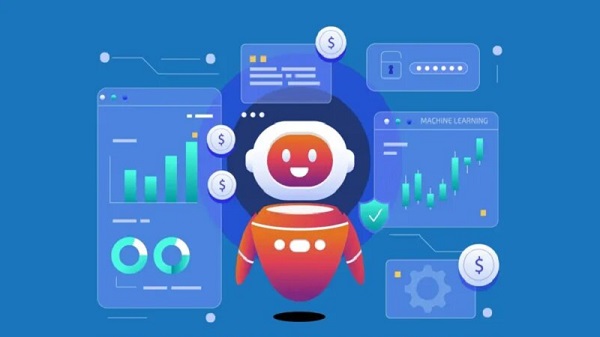Finance and Banking: Conversational AI
Conversational AI has arisen as an expertise that has the potential to change the finance and banking services businesses. The use of Conversational AI algorithms is endless because they support natural language discussions among people and computers. This type of AI has the potential to transform how banks interact with their clients by providing services that are both modified and simple.
A Conversational AI Development Company concentrates on developing modified and bright informal edges where people can get in touch with clients, offer information, and provide provision in a regular and unified manner. Such firms use skilled designers, data scientists, and NLP specialists to create and construct conversational AI benefits that can comprehend and retort human language successfully.
What are Conversation AI Chatbots for Banking and Finance?

Conversation AI effectively embodies its terminology. This is a unique kind of artificial intelligence capable of engaging in a conversation that closely resembles that of a human being. Indeed, some have said that they have successfully developed conversational computer systems in the past. Exposure to such disclosures may lead individuals to perceive them as overstated. How can we ascertain that things have changed this time?
A notable sign of the efficacy of contemporary conversational chatbots is the tendency for individuals to remain unaware of their interaction with a chatbot. Upon the first implementation of these chatbots, organizations saw that consumers often delayed recognizing that they were not engaging in conversation with a human representative.
Chatbots in the banking and finance sectors provide many conversational AI benefits that are handy and effective means of addressing simple but urgent consumer inquiries.
These automated systems can change passwords, verify statements, facilitate money transfers, and even help businesses explore financing options like business credit cards with no personal guarantee – all without the need for prolonged waiting periods with a customer service agent. AI chatbot technology enables the completion of time-consuming activities in a matter of seconds, thereby enhancing the customer experience.
This is only one reason for the widespread adoption of the practice of guiding individuals during interactions with chatbots. Currently, conversation AI is very persuasive, to the extent that such notifications are crucial to prevent people from being confused. However, understanding AI Benefits & Use Cases individuals and companies to make informed decisions and make the most of their potential consequences.
Chatbots in Banking and Finance Trends
As the technology behind chatbots advances, they will surpass their primary purpose of responding to inquiries and progress into fully equipped virtual agents. It gives efficiency and cost benefits in optimizing developments and processes in banks and finance companies. The following are the prevailing trends that are propelling the development of banking chatbots:
LLMs are widely used to provide information to Chatbots
The assimilation of bigger language models (LLMs), like the ones used by OpenAI’s ChatGPT and Google’s Bard, has by now facilitated the expansion of chatbots, which are capable of creating conversational interactions that closely resemble those of humans. Employing a source with a narrower and more focused scope can help overcome numerous challenges associated with LLM models.
The Increasing use of Voice Bots
Recent advancements in Conversational AI in Finance Industries like speech recognition technology and intelligent virtual assistants (IVAs) have facilitated the ability of virtual agents to reply to voice instructions using natural language effectively. This development has resulted in enhanced customer service experiences and enables direct contact with staff.
The Process of Automating more Duties
The capabilities of banking chatbots in managing consumer self-service financial transactions and tasks are expected to be further enhanced. Sophisticated chatbots can use optical character recognition (OCR) methods to read uploaded documents promptly. Additionally, they may utilize entity extraction techniques to extract data, enabling them to identify and address flaws, inconsistencies, or missing fields. Chatbots can upload information into banks’ customer relationship management (CRM) systems. They can then verify the accuracy of the information on the documents and give immediate feedback to guarantee the precision of all submitted information.
Enhanced User-Friendliness
Contemporary chatbots can handle their management and updating without considerable or comprehensive programming expertise. No-code platforms provide financial institutions with the opportunity for adequately skilled employees to enhance the existing programming infrastructure. There is no need to rely on a developer to implement modifications with suppliers if a bit of alteration is required. AI trainers can use robust and user-friendly API self-service features to tailor integrations independently. Modern chatbots are easily accessible, pre-packaged systems that allow for quick customization.
Overall, conversational AI in the finance industries is reshaping the way monetary and bank services are operated by creating accessible and suitable interactions.
Use Cases of Conversational AI Tools
The Benefits & Use Cases of AI technology are numerous and wide-ranging. Below are some of the significant use cases:

1. Lead Nurturing
Lead nurturing in Conversational AI in Finance Industries is revolutionizing customer interactions and connection building. Conversational solutions have the potential to be very advantageous in the cultivation of leads. This is achieved through the comprehension of leads’ readiness to go down the funnel and the identification of their decision-making needs.
2. Increased Revenue
By enabling your organization to analyze each discussion for indications of other items that a consumer may be inclined to buy, it establishes a route to generate fresh money. Conversational AI systems provide extensive data on various consumer interactions, which is advantageous. By using this dataset, one may ascertain:
- Current sources of income.
- Potential income prospects in the future.
- The monetary worth of foregone prospects.
3. Medical Care
The use of conversational AI within the healthcare sector has the potential to help patients acquire a deeper understanding of their health conditions and promptly guide them toward appropriate healthcare practitioners. This minimizes the patient queue for contact center personnel, hence decreasing the need for call drop-offs. By actively involving patients and offering them valuable information, healthcare facilities may effectively reduce the occurrence of patients receiving inadequate counseling.
4. Monitoring Performance
For performance monitoring, a conversational platform facilitates the automated analysis of each client meeting. For instance, Conversational AI in banking industries can recognize and monitor crucial terms that influence conversions or call drop-offs, as well as identify the most efficient agents in your team. You can use the substantial amount of information this resource provides to enhance and optimize company operations.
5. HR
Use cases Conversational AI tools have transformed the way industries interrelate with customers and rationalize their operations. One of the primary uses of this technology by the human resources staff is to facilitate the process of onboarding new workers. Instead of engaging in a telephone conversation to guide individuals through the on-entering process, one may use conversational AI solutions to assume this responsibility.
Crucially, conversational AI comes with several efficiency and cost benefits capabilities to seamlessly integrate with various human resources tools and systems, enabling the automation and optimization of procedures like compensation and payroll. This technology enables organizations to improve the employee experience, streamline operations, guarantee data accuracy, and address frequently asked questions for both new and current workers.
6. IoT Devices
You will come across quite a lot of Internet of Things (IoT) gadgets, like Alexa, Siri, and so on, in present-day homes. Intelligent discussions with users and devices, including microphones and alarm systems, are facilitated by the use of intelligent speech identification algorithms in such devices. The integration of conversational AI with IoT devices enables businesses to derive significant insights.
IoT devices in the medical industry can gather patient data, such as medication use and vital signs. The data is analyzed by conversational AI, which identifies trends and makes predictions on the timing of medical treatment. This enhances efficiency, lowers periods of inactivity, and decreases maintenance costs for enterprises.
7. Customer Support
Lastly, conversational AI is a highly favored customer service or contact center solution, such as Convin.ai, that surpasses chatbots or interactive AI chats in terms of complexity. It can meet consumer requirements and provide precise answers and a customized experience without any human intervention while also continuously improving through knowledge.
8. Monitor Security
Mainly designed to monitor privacy exams, conversational AI platforms can improve compliance with security requirements. These platforms are capable of addressing specific staff inquiries and providing comprehensive information on their results. Conversational AI chatbots possess the capability to not only provide information and oversee test outcomes but also offer pertinent guidance, apprise personnel of recent modifications in cybersecurity protocols, and ensure their awareness of the most recent safety precautions.
9. Lead Generation
A significant number of contemporary customers need more support to reach out to financial or banking institutions due to their expectation of obtaining a forceful marketing campaign for goods, services, and bundles rather than pertinent information. The arduous process of navigating through the phone menu and experiencing delays in service does not enhance the overall user experience. They come across bots that may be seamlessly incorporated into the system and attract prospective clients by providing them with information about banking services without exerting any undue influence to join.
Conclusion
Conversational AI solutions in the finance industry are becoming more popular and are being used by fintech development services provider and banking institutions. This is a straight result of the rising need for services that are both personalized and suitable. A poll that was conducted not too long ago found that 90 percent of banking managers are of the view that Conversational Artificial Intelligence will arise as a significant channel for client interactions in the not-too-distant future. As technology continues to improve at a rapid rate, conversational AI is set to become even more complex and custom-made, providing users with all-in-one and instinctive banking familiarity.
Frequently Asked Questions
1) What are the different kinds of Conversational AI tools?
Companies may pick from several Conversational AI technologies. The most common Conversational AI application is chatbots.
2) Which businesses and sectors can employ Conversational AI?
Conversational AI platforms can be used to create programs for every sector, such as banking and finance, health coverage, commerce and internet shopping, F&B, tourism and lodging, and the entertainment and media sectors.



